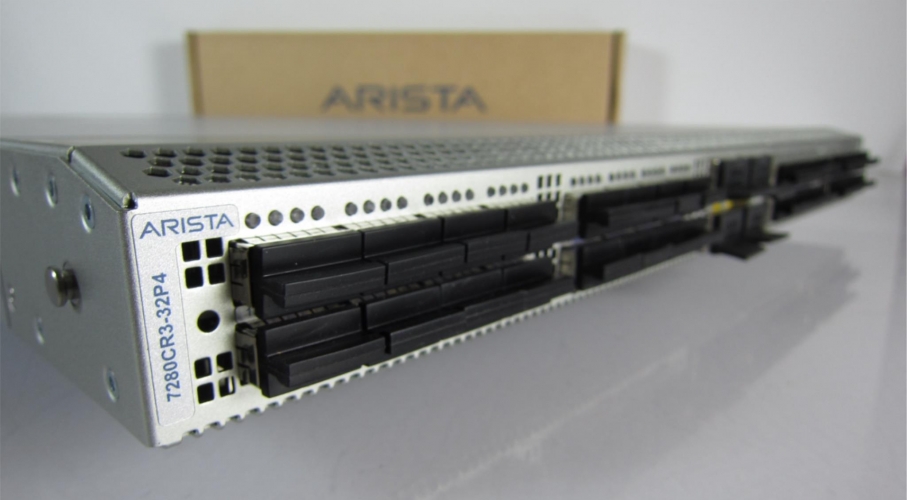Exploring the Arista DCS-7280CR3-32P4-M: Features, Benefits, and Deployment Scenarios
The Arista DCS-7280CR3-32P4-M is a high-performance switch designed specifically for the demands of modern data centers and very large enterprise networks. Part of Arista's R3 series, this model offers a blend of advanced features and cutting-edge performance, making it a compelling choice for organizations aiming to optimize their network infrastructure. It’s also an ideal entry point into 400G ports for those needing to eliminate bottlenecks within a network.
Key Features of the Arista DCS-7280CR3-32P4-M
Port Configuration
- 32 x 100G QSFP Ports: These ports provide high-density 100 Gigabit Ethernet connectivity, suitable for core and aggregation layers in data center networks.
- 4 x 400G OSFP Ports: The 400 Gigabit Ethernet ports offer ultra-high-speed connections, ideal for bandwidth-intensive applications and inter-data center links.
Enhanced System Memory
- The 'M' designation indicates expanded system memory, which enhances the switch's capability to handle complex configurations, larger routing tables, and extensive logging. This is particularly beneficial for environments requiring detailed monitoring and advanced network services.
Layer 2 and Layer 3 Support
- The switch supports a comprehensive suite of Layer 2 and Layer 3 protocols, including VLANs, Spanning Tree Protocol (STP), OSPF, BGP, and IS-IS. This versatility allows seamless integration into various network architectures, supporting both traditional and modern networking paradigms.
Arista EOS Integration
- Running on Arista's Extensible Operating System (EOS), the DCS-7280CR3-32P4-M benefits from a modular and programmable architecture. EOS provides features like Zero Touch Provisioning (ZTP), advanced monitoring, and automation capabilities, streamlining network operations and reducing operational overhead. Arista’s EOS is a modular, Linux-based network operating system designed for high availability, scalability, and programmability in modern data centers and enterprise networks. Built on a single-image architecture, EOS enables consistent operations across all Arista platforms, simplifying management and updates. EOS relies on a standard Linux kernel, where network services like BGP, OSPF, and VXLAN run as independent processes, ensuring stability and ease of troubleshooting. Its modular design allows real-time patching, graceful service restarts, and seamless integration with third-party tools using Linux APIs and CLI extensions. Additionally, EOS supports advanced telemetry, automation, and programmability through its native integration with tools like CloudVision and open APIs.
Benefits of 400G Ethernet and Expanded Memory
400G Ethernet Advantages
- Increased Bandwidth: 400G ports accommodate the growing data demands of modern applications, reducing the need for link aggregation and simplifying network design.
- Future-Proofing: Investing in 400G infrastructure ensures readiness for future technological advancements and scalability requirements.
Expanded System Memory
- Enhanced Performance: Additional memory allows for more extensive routing tables and supports complex network topologies without compromising performance.
- Advanced Features: Supports sophisticated features such as large-scale VXLAN deployments, extensive access control lists (ACLs), and detailed telemetry data collection.
Layer 3 Protocols and Layer 2 Functionality
Commonly Used Layer 3 Protocols
- OSPF (Open Shortest Path First): Facilitates efficient intra-domain routing with rapid convergence.
- BGP (Border Gateway Protocol): Essential for inter-domain routing, particularly in large-scale networks and service provider environments.
- IS-IS (Intermediate System to Intermediate System): Offers scalable and robust routing, often used in large enterprise and service provider networks.
Layer 2 Operation
- The DCS-7280CR3-32P4-M can operate in pure Layer 2 mode, supporting features like VLAN segmentation, STP, and Link Aggregation Control Protocol (LACP). This flexibility is advantageous for networks that require Layer 2 connectivity without Layer 3 routing.
Deployment Scenarios in Network Topology
Data Center Spine Layer
- With its high port density and support for 100G and 400G interfaces, the switch is ideal for deployment in the spine layer of a leaf-spine architecture, facilitating high-speed, low-latency connectivity between leaf switches.
Aggregation Layer
- The switch's versatility and performance make it suitable for the aggregation layer, where it can consolidate multiple access layer connections and provide uplinks to the core or spine layer.
Edge Routing
- Its robust Layer 3 capabilities and expanded memory allow it to function effectively as an edge router, managing external connections and supporting complex routing policies.
The Arista DCS-7280CR3-32P4-M stands out as a versatile and truly exceptional high-performance switch, equipped to handle most any needs of modern networks. Its combination of 100G and 400G ports, enhanced system memory, ease of implementation and management via EOS, and comprehensive protocol support make it a strategic choice for data centers and enterprises aiming to build scalable, efficient, and future-ready network infrastructures at the high-end.
At Terabit Systems, we remain committed to providing cutting-edge networking solutions tailored to our customers' needs. Call us at +1 (415) 230-4353 or click here to connect for a quote or to learn more.

